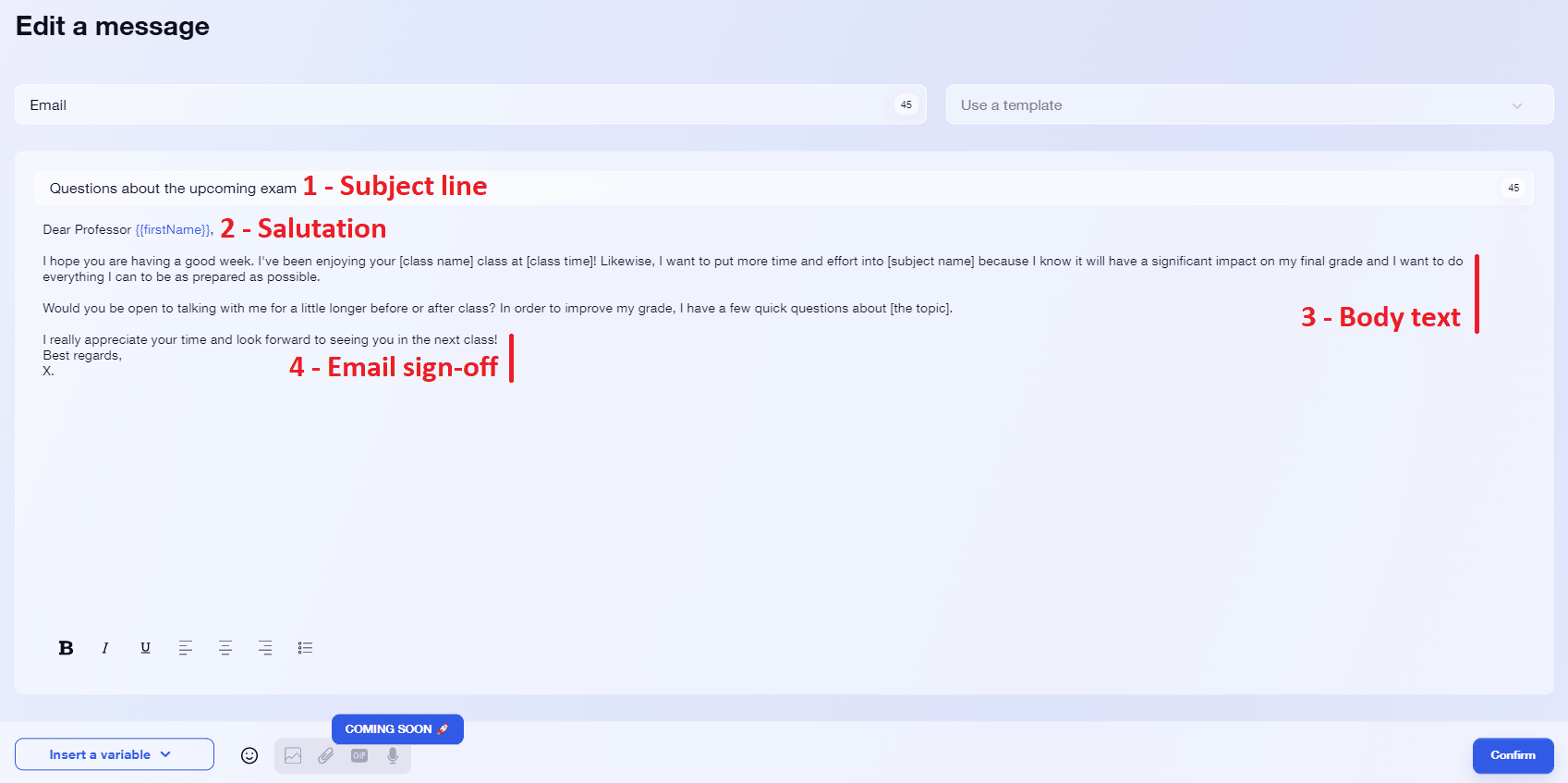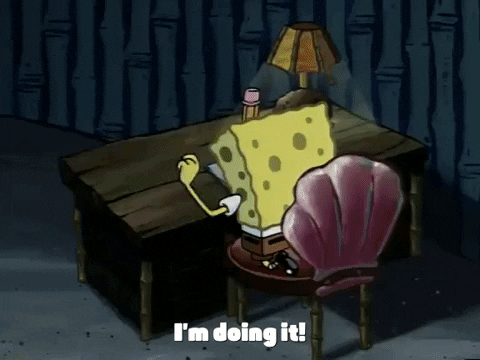- How to End an Email Professionally?
- How to End an Email? 70 Examples of Email Endings
- 10 Phrases for Closing an Email for a Job:
- 10 Ways to Conclude an Email with Thank You:
- 10 Phrases for Warm & Cool Email Sign-offs:
- Form of address: 10 formal examples for a cover letter
- Form of address: 10 friendly examples
- 10 polite expressions for administrative letters
- Conclusion: How to End an Email Formally? How to Finish an Informal Email?
Making sure your emails are consistent with your brand image and showcase the most crucial aspects of your business, is essential. 👌 In this article, you can check How to End an Email and use one of the 30 best email endings to improve your inbound marketing.
Therefore, scroll down to read more about the best practices for email closings in formal or informal situations. Let’s go! 🚀
How to End an Email Professionally?
If you think about the hundreds or thousands of emails that your company sends out each year: you’d agree that it’s a lot, and each one is an impression of your personal branding. 👀
These emails are often sent to your network and prospects’ list, customers, partners, and stakeholders. It is important to understand how each component has an impact in the eyes of the recipients. Elements inside each of these communications, such as the greeting, email body, and closure, all contribute to a good or bad brand impression. 🙊 The closing of an email is equally critical as the subject line, and some may say that it is the most significant element of an email!
The email closing sentence plays a huge role in the message you want to convey to your audience, and thus, you should pay extra attention to it! 🔍
Professional Email Ending Format:
Let’s have a look at what’s typically included in a good email closing. 🧐
A stunningly designed email signature and call-to-action sentence, in the end, will surely make a difference from all the other commercial emails that your contacts receive!

How to End an Email? 70 Examples of Email Endings
Furthermore, there are several factors that influence how an email is closed. ✍️
Who is the email’s intended recipient? What is the email’s purpose? Is this email representing the whole business, or just my personal brand?
An email signature is usually advised whether communicating with a coworker, professor, friend, or family member. 🤗 Knowing who your audience is, as well as other contextual factors, will indicate what is the right way of ending the communication.
In this article, we will first see 10 phrases to properly finish an email in a business situation. Emails to coworkers, employers, recruiters, customers, and even CEOs fall into this category. 💯
Then we’ll go through 10 standard ways to say thank you to conclude an email. Finally, we’ll see 10 phrases for informal emails, such as the ones you send to your friends or family members only. 📩 These 30 examples are ready to copy-paste in any message or to save them in order to create the perfect templates!
10 Phrases for Closing an Email for a Job:
If you don’t know how to write the closing phrase in a job setting, just compare the closure of an email to a formal letter closing to keep it professional. 😅 Since sending a letter through the mail is nowadays equivalent to sending an email, the same protocol and rules can be used for any email marketing strategy. Keep everything professional and cordial. 🤝
Here are a few phrases that can be used as examples of business letters‘ closing sentences: 👇
- Sincerely,
- Regards (or Best regards).
- I look forward to hearing back from you.
- I appreciate your support.
- Let me know how else I can help.
- Please let me know if you have any questions.
- With warmest regards.
- I look forward to our ongoing business.
- Feel free to contact me back.
- I would love to hear back from you.
As explained before, a business-appropriate marketing email template and corporate signature that is routinely used throughout your entire organization has an impact on email etiquette. 🏷️ So, make the effort to ensure that both the sign-off phrase and the signature banner meet the requirements of your company.
The objective is the same whether an email is sent to the entire firm, or it’s a private message with a client. Business people try to interact with others in a way that enhances both their personal image and the image of the organization they work for. 💫
10 Ways to Conclude an Email with Thank You:
The most common email closure is “thank you” which is often used in all the email closures. Think of situations in which you would write a thank-you email to someone. How would you show the recipient that you value their help? What phrase would best to accomplish this? If a friend or member of your family helped you with something, this should come naturally. 🥰 But what about in a work or commercial environment? Here are some ways to conclude a thank-you message:
- Thank you for your support.
- Thank you for your time.
- Thanks, {{FirstName}}!
- Thanks a lot.
- Thank you so much.
- I’m very grateful for X.
- I appreciate your help with X.
- Thank you in advance.
- Many thanks for the opportunity.
- I really appreciate your support.
Also, keep in mind that you should thank the person in advance when asking for a favor or for help in an email. Even when they haven’t yet provided assistance, you should nevertheless express gratitude as though they already have! 🤲
Furthermore, here’s an article with 5 templates that will help you write a professional “thank you” email correctly. You can thank me later! 😜
10 Phrases for Warm & Cool Email Sign-offs:
Finally, in this section, I will show you how to finish an email with fun & cool email sign-offs. 🤙 There are several great sign-off words you can use, and while not all of them are appropriate for every scenario, these 10 phrases will sure help you get your imagination going! 🌈 Check out these informal email closing examples:
- Talk to you later.
- Later (or See you later!).
- Lots of love.
- Peace out!
- Best. (short for Best regards).
- Cheers!
- Have a great weekend, {{FirstName}}.
- Can’t wait for your reply.
- Warm/Best wishes.
- Stay tuned…
As you can see, each of these closings is appropriate for a variety of sequences. For example, you can use “Love.” to finish an email to a friend or family member but not to a coworker. 😳 “Warm or Best wishes” can be used in both official and informal communications. Professional emails or personalized messages where you wish to maintain a certain professional tone, you should include phrases like “All my best” or “Respectfully”. 👌
When drafting a sales email, you may want to spark the recipient’s attention so that he/she reacts or excitedly anticipates your answer, and use a closure like this one “Stay tuned”. Also, “Cheers” is a cheerful and rather informal term, yet it may establish the perfect relaxed tone in a corporate situation as well. 😀
Form of address: 10 formal examples for a cover letter
We’ll be much less detached and familiar than with the previous section, but don’t worry, nothing too bad 👿. We’ll show you right away which formulas are most appropriate:
- Please accept, Madam, the expression of my deepest respect.
- I look forward to receiving your reply.
- Please accept, Sir, the assurances of my highest consideration.
- Please accept, Sir, my most sincere greetings.
- Please accept, Sir, my respectful and sincere greetings.
- I wish you a pleasant reception and remain at your disposal for any further information.
- I look forward to being able to express my motivation to you, please accept the assurances of my highest consideration.
- I remain at your disposal to arrange a meeting in the next few days.
- I look forward to hearing from you.
- Please accept, Sir, Madam, the assurance of my highest consideration.
Form of address: 10 friendly examples
Using a greeting with a friend is not forbidden. Usually we don’t really do it ❌ and tend to text rather than email. However, here are some examples to help you.
- Best regards.
- Best wishes.
- Yours truly.
- Yours sincerely
- Best regards.
- Please find here the assurance of my friendship.
- Yours sincerely
- With friendship.
- Yours faithfully.
- I look forward to seeing you again.
10 polite expressions for administrative letters
We’re going to take a step back from prospecting and focus on what we do in our daily lives. We will give you 10 formulas to include in your letters and emails 📩 when you have to write to an administrative entity.
- With my thanks.
- Sincerely yours.
- Yours sincerely.
- I look forward to hearing from you.
- Thank you for the attention you will give to my case.
- Thank you for your cooperation.
- Thank you for your attention to this matter.
- With my thanks.
- Respectfully.
- Very Respectfully.
Conclusion: How to End an Email Formally? How to Finish an Informal Email?
In conclusion, let’s say that you worked hard to make your email appealing and understandable. Thus, the body of your email may be flawless, but it could all go wrong if you use the wrong sign-off phrase! 😖 It’s only a brief sentence followed by your personalized signature, but establishing the appropriate tone to finish your email frequently takes a surprising amount of effort and refinement. 💪
When deciding how to conclude an email, it’s important to consider the context as well. What works for a friend or close colleague will not work for a distant acquaintance or someone you’ve never met before, in a strictly professional way. 🥸
👉 Here’s an overview of some of the most frequent email closings, for formal and informal communications:
Formal Email Sign-off Examples
- “Regards”:
Yes, it’s a little dry, 🤷 but it works in professional emails since there’s nothing unusual or inappropriate about it.
- “Sincerely”:
This sign-off strikes the appropriate tone for official correspondence. 🙂 Keep in mind that it may appear stiff in more informal business correspondences.
- “Best wishes”:
This is a safe pick due to its nice combination of warmth and formality, but be careful of its “greeting-card” vibe 🎅 and use it only when it fits well with the tone of your email.
- “Thanks in advance”:
Apparently, emails that include a “thank you” phrase get the most responses. Perhaps it’s because this sign-off shows gratitude while also establishing an expectation—you’re indicating you’ll be thankful when (not if) the person you’re emailing responds. 🤨 Thanking someone in advance may come out as excessively demanding in more formal situations, so use it with caution.
- “I appreciate your [help, support, feedback, etc.]”:
Using “appropriate to” express your gratitude to someone who has helped you. 💖
- “Looking forward to hearing from you”:
This one seems pleasant at first, but it could have a passive-aggressive tone to it. 😯 The recipient may perceive an implication of “You should respond.”
- “Yours truly”:
Do you genuinely “belong” to the recipient? Nope. 🤣 Unless you’re sending a letter home to your parents from summer camp, this seems fake and cheesy.
- “Respectfully” / “Respectfully yours”:
This is OK if you’re writing a formal letter to the President, but it’s too formal for anything else. 🙅
- “Have a nice day”:
It’s best to keep this type of sign-off out of your professional correspondence, although this one’s fine if you’re emailing a correspondent that you’ve worked with before, and that you have a good relationship with them. 🤗

Informal Email Sign-offs Examples
- “Cheers”:
This sign-off is not likely used to end an email response (that isn’t a thank-you). It works great in pleasant and conversational emails, but unless you’re genuinely British or Australian, it may come out as forced in more professional circumstances. We all know the traditional “Cheers, mate!” that australians like to use. 🦘
- “Best”:
“Best wishes” or “Best regards” are being conveyed in a more cheerful way. 🤩 If you get many emails, you’ll notice that almost everyone uses this sign-off. That familiarity makes it smooth, in the same way that formal emails are effortless. The disadvantage is that it might be safe and boring, particularly if you want your message to be more dynamic and catchy.
- “As ever”:
This is a good option for people with whom you have a long-term professional connection. 👴 It reassures your contact that things are as good as they’ve ever been between you.
- “Thanks”:
When you want to communicate gratitude, a simple “thanks” is often a good option. However, it can express a tone of eagerness, exactly as “Thank you in advance”. So, use it for when you truly are expecting an answer.
- “Lots of love”:
This one is best reserved for family, close friends, and your significant other. The same rule applies with “Hugs & Kisses” or the shorter version “XOXO”. 😍
- “Thx” or “Rgrds”:
Unless you’re 13 years old, then avoid using this type of writing, haha! 😝 This isn’t a text-messaging chat. Make use of all the words in the alphabet.
- “Take care”:
Take care seems fine on the surface, but upon deeper inspection, it may imply that the receiver should be mindful of potential dangers. 🤐 So refrain from using this sign-off in formal conversations because some people might take it literally!
- [Nothing at all]:
We live in a world where people routinely email from mobile devices, so it’s very common to omit a signature as an email chain develops. However, failing to sign an initial email or not using a formal signature for your outgoing emails comes across as impersonal. 🙈
- [Name] or [Initial]:
While this type of sign-off may work for short, informal emails, it’s too cold for most people, ❄️ especially when you’re connecting with the recipient for the first time.
Bonus: Bad Sign-off Example
- “Sent from my iPhone”:
Even though this email closing happens mostly by mistake when the sender forgets to include an original signature, I felt it was worth emphasizing that this isn’t an appropriate sign-off 🚫 no matter the context…However, this may be the most common of all sign-offs! 😱 It indicates that you don’t care enough about your recipient in order to change the default email signature. So whether you’re talking to friends or colleagues, please avoid this type of mistakes.

What is the Best Email Sign-off If you Want a Response?
To know what is the best email sign-off, you need to understand that the last thing your audience views after reading your message is the email closure, and it may influence how soon they answer— or whether they respond at all. 👀
Imagine meeting a new business contact at a professional event. You wouldn’t just turn and walk away once your chat was over. 🚶 That would be considered as rude, give a negative impression, and most likely prevent further interactions with this prospect. 😫 Instead, you would say something like:
“It was a pleasure meeting you! Please accept one of my business cards. I look forward to hearing from you!”
👉 Think of your email sign-off as the conclusion of a discussion. You have a greater chance of receiving a good response if you use warm, polite, and professional language with a clear call-to-action, like explained before.
Plus, here’s an article if you want to learn the method of how to make your LinkedIn response rates go from 6% to 38%! 🧨
Use Waalaxy Email Automation Tool!
However, you can also make use of an email automation tool like Waalaxy CRM, in order to prepare a drip campaign in which you can guide your leads through your sales funnel and finally convert them into paying customers.
Emailing campaigns with Waalaxy are super easy to set up, and it will save you lots of time and money! 🤑 Who wouldn’t want that?
There are 3 methods to launch a new prospecting campaign:
- Send an email to your prospect list,
- Setting up a scenario from the campaign tab,
- Using the LinkedIn imports in order to find new prospects.
If you want more details about launching a campaign, then read this article, and you’ll be amazed. 🥰 The best part is that you can save all the email templates that you want, that way you can easily reuse them for other campaigns and even create a multichannel marketing strategy using emails and automatized LinkedIn actions (like send connection requests, visits, follow, and send messages).
In addition to setting up automatic email campaigns, you can also use the tips in this article in order to help you increase your answer rates, by sending personalized messages and by keeping the attention of your recipients! 💥
Discover Waalaxy 🪐FAQ: How to Professionally End/Close an Email?
How to End an Email to a Professor/Teacher?
Sending emails to professors can have a negative or positive impact 🤫, much like emails with business professionals. Unfortunately, sometimes students send unprofessional messages to teachers, and this can result in not getting a grade improvement or a deadline extension… Please, don’t be that kind of student!
Instead, learn how to end an email to a professor, teacher, or other education-related professionals by using this template: 👇
How do You Politely End a Business Email to a Client?
Here are a few things to consider if you politely end a business email to a client: 👇
- ✅ Please use your full name. In your email ending, always include your first and last name, especially in the first few correspondences. This way, your receiver knows who you are and is less likely to mix you up with other contacts who have the same first name, for example. 🤯
- ✅ Keep it professional. Determine the suitable tone to use in your closing, thanks to context cues. If you’re emailing someone you’ve never met, avoid informal sign-offs like “Chat soon!” to maintain a professional tone. If you’ve exchanged multiple emails and believe a more relaxed closing is more suitable, feel free to “match your audience’s energy”. ⚡
- ✅ Determine if a closing is necessary. It might be tempting to omit the closure after exchanging multiple emails with someone. In this instance, it’s a good idea to include a closure in your email. Even if your talks have gotten more informal, an email closure demonstrates attention to detail and professionalism. 💯 Furthermore, the receiver may forward your email to individuals inside the business who have not previously corresponded with you. A well-thought-out conclusion will make a good impression on them, while also making the communications clear and easy to follow-up.
Furthermore, this is what a professional email closing should look like: 🤓
👉 There are 4 steps you should consider when writing your email closing:
1. Closing line
The closing line of your email should not only express appreciation to the recipient for reading your message, but it should also include a call-to-action or phrase that either motivates the recipient to react or indicates that you anticipate a response. 👂 The closing line used in this example is this one:
“I look forward to meeting with you next Monday.
Thank you,”
2. Full name
Always use your first and last name in your email signature to minimize confusion and to help them remember you. 🌌 Using your entire name in your email signature, resume, cover letter, and any other materials you send should boost your chances of receiving a response. In this case, we used the name:
“Paul Alien”, as an example. 👽
3. Job title
You can mention your current job title to close an email, as it might be useful to include a title that simply describes what you do for the company. For example:
“Chief Galaxy Officer”. (Haha, try not be this vague though!) 🤣
4. Contact info
Even if the person receiving your message already has your email address, it’s always a good idea to give other contact information, such as your work phone number or other contact information, like this one: 🪐
“www.waalaxy.com
+33 xxx xxx xxx”.
There you go, you have all the tips you need! 🚀
How to Start a Professional Email?
To finish, here are more tips you can apply to start a professional email:
- Understand your target market. 👂 Your email greeting and opening line should represent the relationship you have with your readers. Think about if you’re writing for a customer, executives, a professional acquaintance, or a close coworker.
- Make your goal clear. 🎯 When the objective of your email is not obvious, the reader may get confused or frustrated. To prevent overlooking this important component, try including the objective of your email within the first phrase or even better, put it in the subject line, so the reader knows what to expect from your message.
- Use online software tools, to check spelling or to send automated messages (if applicable). 🤖 Spelling is super influential when conveying a message, specially in professional environments it really counts if you want to be taken seriously! So be careful with it. 🔔 Furthermore, maybe you need to send a reminder email in two weeks from now, and you don’t want to forget about it, or perhaps you won’t be available at the time. So that’s when automation tools, like Waalaxy, come in handy!
👉 Find here the most commonly used greeting formulas:
Make sure you use commas, punctuation and grammar correctly, since first impressions can make or break your company image, or tarnish the brand image. 😣 You can find how to end an email professionally with the templates above in this article! ⚡

Great! 👏 Now you know exactly How to end an email, right? If you still have any doubts, do not hesitate to contact us via chat or LinkedIn.
Take care, young Padawan. 🖖













